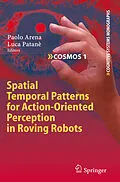This volume collects the most significant results of the European research Project called "SPARK", whose aim was to develop new cognitive architectures and new sensing-perceiving-moving artefacts, inspired by the basic principles of living systems and based on the concept of "self-organization" in complex systems generating spatial temporal patterns.
The book is organized in three parts. Part I "Principles of insect perception" reports a thorough survey of the state of the art in perception for action.
The central Part II "Cognitive Models" describes new approaches to attain high cognitive capabilities in roving robots, for which detailed Structures are still lacking, even referring to insect brain. Some of the models introduced rely on the insect-inspired parallel sensory-motor pathways, others exploit the emergence Spatial-temporal Patterns (used as perceptual states) arising in non linear Reaction-Diffusion Equations, some others build upon the neural networks modelling Stick Insect locomotion.
The last part of the book Part III "Software/Hardware cognitive architecture and experiments" is related to the implementation of the proposed cognitive models on a software /hardware FPGA-based architecture embedded on wheeled and legged robots. Multimedia material, related to the experiments presented in the book, is available on the SPARK web page: www.spark.diees.unict.it
Zusammenfassung
The basic principles guiding sensing, perception and action in bio systems seem to rely on highly organised spatial-temporal dynamics. In fact, all biological senses, (visual, hearing, tactile, etc.) process signals coming from different parts distributed in space and also show a complex time evolution. As an example, mammalian retina performs a parallel representation of the visual world embodied into layers, each of which r- resents a particular detail of the scene. These results clearly state that visual perception starts at the level of the retina, and is not related uniquely to the higher brain centres. Although vision remains the most useful sense guiding usual actions, the other senses, ?rst of all hearing but also touch, become essential particularly in cluttered conditions, where visual percepts are somehow obscured by environment conditions. Ef?cient use of hearing can be learnt from acoustic perception in animals/insects, like crickets, that use this ancient sense more than all the others, to perform a vital function, like mating.
Inhalt
Systems.- Perception for Action in Insects.- Principles of Insect Locomotion.- Low Level Approaches to Cognitive Control.- Cognitive Models.- A Bottom-Up Approach for Cognitive Control.- Mathematical Approach to Sensory Motor Control and Memory.- From Low to High Level Approach to Cognitive Control.- Complex Systems and Perception.- Software/Hardware Cognitive Architecture and Experiments.- New Visual Sensors and Processors.- Visual Algorithms for Cognition.- SPARK Hardware.- Robotic Platforms and Experiments.
